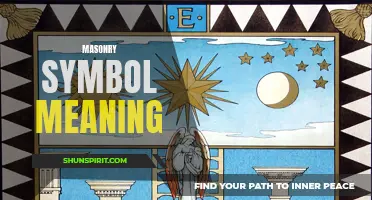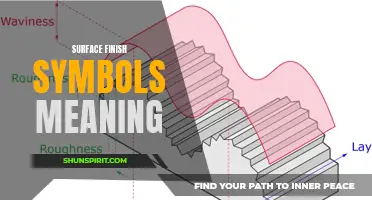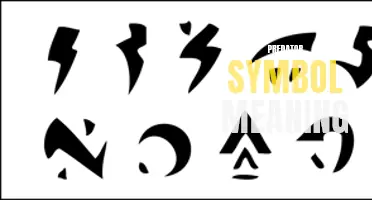
The sun and moon have captured the attention and imagination of humanity for centuries. These celestial bodies not only guide our daily lives with their rise and setting, but they also hold deep symbolic meanings across various cultures and belief systems. From representing light and enlightenment to embodying balance and duality, the symbolism of the sun and moon offers a fascinating glimpse into the human quest for understanding the universe and our place within it. In this article, we will explore the rich and diverse meanings behind these iconic symbols, shedding light on their importance and significance in our collective consciousness.
What You'll Learn
- What are the symbolic meanings associated with the sun and the moon in various cultures?
- How do the sun and moon symbols differ in different mythologies and religious beliefs?
- What are the psychological interpretations of the sun and moon symbols in dreams and symbolism?
- How do the sun and moon symbols represent masculine and feminine energies?
- Are there any common themes or archetypes related to the sun and moon symbols in literature and art?

What are the symbolic meanings associated with the sun and the moon in various cultures?
The sun and the moon have held significant symbolic meanings in various cultures throughout history. These celestial bodies are often seen as powerful symbols representing different aspects of life, nature, and spirituality. Let's explore some of the symbolic meanings associated with the sun and the moon in different cultures.
In ancient Egyptian culture, the sun was worshipped as the god Ra, representing light, power, and life. The Egyptians believed that Ra traveled across the sky during the day and sailed through the underworld at night, bringing light and warmth to the world. The sun was also associated with creation and rebirth, symbolizing the cycle of day and night and the eternal renewal of life.
In Norse mythology, the sun and the moon were seen as siblings; the sun was personified as the goddess Sol, while the moon was personified as the god Mani. Sol was associated with warmth, light, and fertility, while Mani was seen as mysterious and enigmatic. The two celestial bodies were believed to be chased by wolves, representing the eternal struggle between light and darkness.
In Chinese culture, the sun and the moon are associated with the principles of yin and yang. The sun represents yang, representing warmth, activity, and masculine energy, while the moon symbolizes yin, representing coolness, calmness, and feminine energy. The Chinese believed that the sun and the moon are in constant balance and harmony, and their movements influence the energies of life on Earth.
In Native American cultures, the sun and the moon also hold deep symbolic meanings. The sun is often seen as a powerful and positive force, representing light, vitality, and energy. It is associated with growth, abundance, and healing. The moon, on the other hand, is linked to intuition, spirituality, and the cycles of nature. It is often seen as a guide in the dark, representing the inner self and emotional well-being.
In Hindu mythology, the sun is personified as the god Surya, representing the soul, consciousness, and divine light. Surya is believed to have healing powers and is worshipped for his ability to grant blessings and remove negative energies. The moon, on the other hand, is associated with the god Chandra, symbolizing the mind, emotions, and the subconscious. Chandra is believed to have a calming and soothing influence on the mind and is often revered as a deity of peace and tranquility.
These are just a few examples of the symbolic meanings associated with the sun and the moon in various cultures. The celestial bodies have fascinated and inspired humans for millennia, serving as reminders of the interconnectedness of life and the forces that govern our existence. Whether representing light and darkness, masculine and feminine energies, growth and intuition, or consciousness and subconsciousness, the sun and the moon continue to hold deep symbolism and meaning in cultures across the world.
The Symbolic Meaning Behind the Chair: Exploring its Significance
You may want to see also

How do the sun and moon symbols differ in different mythologies and religious beliefs?
In various mythologies and religious beliefs around the world, the sun and moon symbols hold significant meaning. These celestial bodies are often associated with various deities, concepts, and interpretations, which can differ greatly across different cultures. While there are common themes, the differences in symbolism can shed light on the diverse beliefs and narratives that exist globally.
The sun, as a symbol, represents warmth, light, energy, and life. In many mythologies, the sun is personified as a deity or celestial being. For example, in ancient Egyptian mythology, the sun was associated with Ra, the powerful god of the sun and creation. Ra was often portrayed as a powerful figure, and his journey across the sky was seen as a representation of the cycle of life and death. Similarly, in Norse mythology, the sun was personified as Sol, a goddess who rode a chariot across the sky. Sol represented the life-giving force and was an essential part of Norse cosmology.
In contrast, the moon symbolizes mystery, femininity, change, and rhythm. While the sun is often associated with male deities, the moon is often linked to goddesses in various mythologies. In Greek mythology, the moon was personified as Selene, daughter of the Titans Hyperion and Theia. Selene was often depicted as driving a chariot across the night sky, illuminating the darkness. In other cultures, such as in Maya mythology, the moon was associated with the goddess Ix Chel, who represented fertility, childbirth, and weaving.
Despite these variations, the sun and moon symbols are often interconnected, representing balance and complementary aspects of life. In many belief systems, the sun and moon are seen as cosmic lovers, with their interactions influencing the cycles of nature and the world. This concept is prevalent in ancient Chinese philosophy, where the sun (yang) and moon (yin) represent opposing yet interconnected forces that maintain harmony and balance.
In some mythologies, the sun and moon are also believed to be involved in the creation of the world. In Norse mythology, the sun and moon were created from the sparks and fragments of celestial bodies by the gods. Similarly, in Hindu mythology, the sun and moon were created from the cosmic body of the supreme deity, Brahma.
The symbolism of the sun and moon can also be seen in religious beliefs. In Christianity, the sun is often associated with the divine light and glory of God, representing His presence and power. The moon, on the other hand, is linked to spiritual enlightenment and the reflection of God's light. In Islamic beliefs, the sun and moon are mentioned in the Quran, signifying signs of Allah's creation and power.
It is fascinating to explore the diverse interpretations and symbolism of the sun and moon symbols across mythologies and religious beliefs. These variations highlight the richness and complexity of human narratives and the importance of celestial bodies in shaping our understanding of the world. Whether representing life and energy or mystery and femininity, the sun and moon continue to captivate and inspire people across different cultures.
The Symbolic Meaning of Shells: Exploring Their Spiritual Significance
You may want to see also

What are the psychological interpretations of the sun and moon symbols in dreams and symbolism?
The sun and moon are two of the most prominent celestial objects that have appeared in dreams and symbolism throughout human history. We often attribute deep meanings and interpretations to these symbols, as they represent powerful forces of nature and have significant psychological implications. In this article, we will explore some of the common psychological interpretations of the sun and moon symbols in dreams and symbolism.
The sun, often associated with light, warmth, and energy, has long been regarded as a symbol of life and consciousness. In dreams, the sun symbolizes vitality, power, and enlightenment. It represents the conscious mind, the ego, and one's inner self. When the sun appears in a dream, it may indicate a heightened sense of self-awareness, confidence, and personal growth. It can also signify a time of clarity, inspiration, and renewed energy.
Psychologically, the sun represents the masculine principle, with its active and assertive qualities. It symbolizes strength, creativity, and leadership. In certain dream scenarios, the sun may indicate a need for assertiveness, courage, or a desire to take control of one's life. The sun's appearance in dreams can also represent guidance and protection, showing the dreamer the way forward and illuminating their path.
On the other hand, the moon represents the feminine principle – the receptive, intuitive, and emotional aspects of the psyche. It symbolizes the unconscious mind, the shadow self, and the hidden desires and emotions. In dreams, the moon often signifies the need for nurturing, emotional healing, and self-reflection. It can also represent femininity, sensuality, and maternal instincts.
Psychologically, the moon is associated with the emotions, dreams, and the imagination. It represents the cyclical nature of life, the ebb and flow of emotions, and the mysterious aspects of the psyche. When the moon appears in a dream, it may suggest a time of emotional transformation, introspection, or the need to connect with one's intuition. It can also symbolize a subconscious desire for balance, harmony, and stability.
The combination of the sun and moon symbols in dreams is particularly significant. It represents the integration of the conscious and unconscious aspects of the self. The sun and moon together may signify a harmonious union of the masculine and feminine energies within the dreamer. This union reflects a state of wholeness, balance, and self-acceptance.
In symbolism, the sun and moon represent opposing yet complementary forces, such as light and darkness, day and night, and active and passive energies. They symbolize the duality and interconnectedness of life. The sun is often associated with the rational, logical, and conscious aspects of the mind, while the moon symbolizes the intuitive, emotional, and subconscious realms.
The psychological interpretations of the sun and moon symbols in dreams and symbolism are deeply personal and vary from individual to individual. Dreams are highly subjective experiences, and the meaning of these symbols is influenced by personal experiences, cultural contexts, and individual associations.
In conclusion, the sun and moon symbols in dreams and symbolism hold profound psychological interpretations. The sun represents the conscious mind, vitality, and power, while the moon embodies the unconscious mind, emotions, and intuition. Together, they symbolize the integration of the masculine and feminine energies within the self. Understanding the psychological significance of these symbols can offer insights into our own personal growth, inner struggles, and desires for balance and self-realization.
Unraveling the Mysteries of Hawaiian Petroglyphs: Symbols and Their Profound Meanings
You may want to see also

How do the sun and moon symbols represent masculine and feminine energies?
The sun and moon have long been used as symbols to represent masculine and feminine energies. These symbols originate from ancient cultures that observed and worshiped celestial bodies, attributing specific characteristics to each.
In many cultures, the sun is associated with masculinity. The sun is seen as a powerful, active force, representing strength, power, and vitality. It is often depicted as a strong and radiant figure, symbolizing the strength and energy typically associated with men. The sun is also associated with fertility and the warmth necessary for growth and life to thrive. Masculine energy is often described as assertive, active, and outwardly focused, similar to the qualities of the sun.
On the other hand, the moon is often associated with femininity. The moon is seen as a gentle, calming force, representing intuition, emotions, and nurturing. It is often depicted as a soft and serene figure, symbolizing the calm and soothing qualities typically associated with women. The moon is also associated with the ebb and flow of the tides, resembling the cyclical nature of a woman's menstrual cycle and the phases of her life. Feminine energy is often described as receptive, introspective, and inwardly focused, similar to the qualities of the moon.
The sun and moon are often portrayed together to represent the balance and harmony of masculine and feminine energies. This dualistic representation is found in various mythologies and belief systems, highlighting the interconnectedness of these two fundamental forces. It is believed that when the sun and moon are in harmony, there is a sense of balance and wholeness in the universe.
The sun and moon symbols also play a significant role in astrology, where they represent the two primary archetypes of the masculine and feminine energies. Astrology holds that everyone has both masculine and feminine energies within them, and the balance between these energies can affect an individual's personality and behavior.
In modern times, the symbolism of the sun and moon continues to be widely used. It can be seen in various art forms, jewelry, and even in popular culture. For example, in Tarot cards, the sun often represents vitality, success, and abundance, while the moon symbolizes intuition, dreams, and emotions.
In conclusion, the sun and moon symbols represent masculine and feminine energies in a variety of ways. The sun embodies the qualities typically associated with masculinity, such as strength, power, and assertiveness, while the moon embodies the qualities typically associated with femininity, such as intuition, emotions, and nurturing. Together, these symbols represent the balance and harmony of masculine and feminine energies, reminding us of the interconnectedness of these fundamental forces in our world.
Understanding the Symbols on Your Danby Air Conditioner Remote: A Guide
You may want to see also

Are there any common themes or archetypes related to the sun and moon symbols in literature and art?
The sun and moon symbols are prevalent in literature and art across various cultures and time periods. These celestial bodies have captivated human imagination for centuries, and as such, they have become associated with numerous themes and archetypes. In this article, we will explore some of the most common associations related to these symbols.
- Light and darkness: The sun is often associated with light, warmth, and life, while the moon is associated with darkness and mystery. This dichotomy between light and darkness is frequently used to represent the eternal struggle between good and evil or knowledge and ignorance.
- Masculine and feminine: In many cultures, the sun is considered a masculine symbol, representing strength, power, and assertiveness. On the other hand, the moon is often seen as a feminine symbol, representing intuition, emotions, and the subconscious. This association reflects traditional gender roles and archetypes found in many societies.
- Time and cycles: Both the sun and moon follow predictable cycles, which have been associated with various aspects of time. The sun's daily rise and set symbolize the passage of days, while the moon's monthly phases represent the passing of months or lunar cycles. These cyclical patterns have been associated with concepts such as renewal, rebirth, and the eternal nature of existence.
- Dualism and unity: The sun and moon can also symbolize the unity of opposites or the reconciliation of dualities. This can be seen in various mythologies where the sun and moon are depicted as lovers or siblings who are eternally separated but still connected. These symbols are often used to convey the idea that opposing forces are necessary for balance and harmony.
- Celestial guidance: The sun and moon have long been used as navigational guides, helping humans find their way in the world. As such, they have come to symbolize guidance, enlightenment, and truth. In literature and art, the sun and moon often appear as guiding lights, leading characters through difficult journeys or illuminating hidden truths.
- Transformation and transcendence: The sun and moon have also been associated with transformation and transcendence. The sun's ability to rise and set each day represents the cyclical nature of life and death, while the moon's ability to change its appearance symbolizes the ever-changing nature of human emotions and experiences. These symbols are often used to depict personal growth, spiritual awakening, or the journey towards enlightenment.
In conclusion, the sun and moon symbols in literature and art carry various themes and archetypes. From representing light and darkness, to embodying masculine and feminine energies, to symbolizing cycles, unity, guidance, transformation, and transcendence, these celestial bodies have captured the imagination of countless artists and writers throughout history. Their universal appeal lies in their ability to convey fundamental aspects of the human experience in a simple yet profound manner.
The Hidden Symbolism Behind Lady Gaga's Chromatica Album Cover and Its Deep Meaning
You may want to see also
Frequently asked questions
In literature and art, the sun is often used as a symbol of life, warmth, and light. It represents energy, vitality, and growth. The sun is often associated with positive qualities such as happiness, joy, and enlightenment. It can also symbolize power, leadership, and authority. In many cultures, the sun is seen as a god-like figure and is associated with fertility and creation.
In literature and art, the moon is often used as a symbol of femininity, intuition, and mystery. It represents the subconscious mind and emotions. The moon is associated with change, transformation, and cycles. It can symbolize the passage of time and the ever-changing nature of life. The moon often has a calming and soothing effect and is often linked to the concept of dreams and the nocturnal world.
When the sun and moon are depicted together, they often represent the balance between opposing forces or dualities. The sun can symbolize the masculine or yang energy, while the moon represents the feminine or yin energy. Together, they represent harmony and the unity of opposites. The combination of the sun and moon can also symbolize a union of the conscious and unconscious mind or the integration of the spiritual and physical realms. This symbolism is often associated with transformation and enlightenment.







